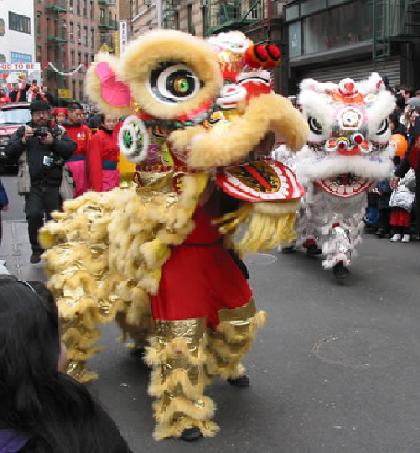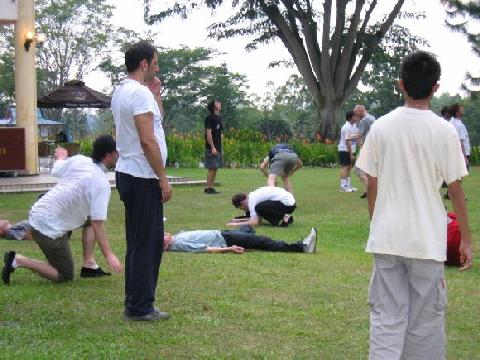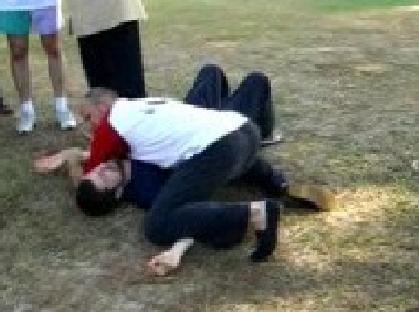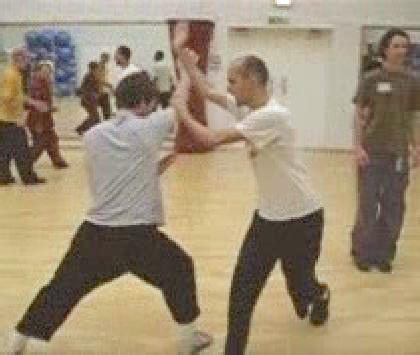January 2006 (Part 3)
SELECTION OF QUESTIONS AND ANSWERS

Question 1
Over the years I have had experience with Yang-style Taijiquan, some very basic instruction on Chi Kung, tasted a few other martial arts (Brazilian Jiujitsu, Kempo) and I diligently practice zazen meditation every morning and night, which has lead to amazing experiences. I am incredibly passionate about cultivating my chi despite the fact that I have never fully learned the tai chi form, due to my moving around a lot.
— Alex, USA
Answer
If you have no experience of chi despite your training of Taijiquan and chi kung over the years, and are passionate about cultivating it, my Intensive Chi Kung Course is a golden opportunity for you. You will experience chi on the very first day of the course itself, and you will be able to cultivate it competently on your own after the three-day course.
But if you think that my fee of US$1000 is too expensive, or Malaysia is too far away, then you should seriously re-examine your decision to dedicate your life to cultivating an internal art.
Question 2
More than anything I have the intention of dedicating myself to intense training of an internal art, such as Tai Chi, Ba Gua, hi kung, etc. but it's very important that I find a serious master, preferably someone of great attainment. I was wondering if you could recommend a place of authentic “intensity” somewhere in Asia which is open to foreigners.
Answer
It may be a surprise to many people that today it is difficult to fnd a place in Asia where one may stay in with a master to cultivate an internal art like Taijiquan for an extended period of time. Even in China, the original home of many internal arts, it is rare to find these arts today. Taijiquan is practiced in modern China not as an internal martial art but as an external demonstrative sport, where both combat application and internal force are absent.
Perhaps such a situation reflects the cycle of cultural evolution. Internal cultivation was wide-spread and advanced in countries like China and India in the past, when these countries were at the height of their cultural achievement, and at a time when the West was “primitive” by comparison. Now the situation is reversed. The West is at her height whereas China and India are relatively “primitive”.
What the people of China and India want now is economic progress rather than spiritual development. When their societies have become properous, the need for spiritual cultivation will surface again. Indeed now it is more difficult to find good yoga teachers or good chi kung teachers inside than outside India and China. This does not mean that there are no longer good teachers in these countries, but it is not easy to find them.
But before you embark on your search, which may take some time, it is wise to be clear of both what and why you are searching for. Do you, for example, have a sound understanding of Taijiquan, Baguazhang and chi kung? Without such an understanding, it is easy to fall into the mistake of spending many years on an art which you think was authentic, but discover later that it is a vastly debased form. Many people have made this mistake, and most of them having spent many years on their art, continue to believe what they practice is authentic despite great differences between what they experience and what their art is purported to give.
Many people who have practiced and taught Taijiquan for years fall into this situation. They know that they have no internal force, and they cannot defend themselves even against an ordinary attacker. Yet they insist vehemently that theirs is authentic Taijiquan. They appear so convinced in their insistence that one wonders whether they really do not know Taijiquan is an internal martial art, or that they choose to lie to themselves. When given an opportunity to experience internal force and combat application, like in my Intensive Taijiquan Course which can help them to convert their Taiji dance into an internal martial art, they dare not face the truth, for fear of breaking the illusion that they have nurtured for years.
Having found out the “what”, you should examine the “why”. Why do you want to dedicate yourself for years to an internal art? Is it just a fancy or a mission you want to accomplish? Why do you want to embark on the mission? What will your life style be during your training period as well as after you have accomplished your mission? These are some important questions you should ask yourself, and more importantly answer sincerely.
Also remember that finding an authentic master is very difficult, but persuading him to teach you may be more difficult. But if you are serious about your vision, you should be able to overcome these hurdles.

Participants to Sifu Wong's intensive courses in Malaysia experience chi flow on the very first day of the courses. Sometimes the chi flow can be quite extra-ordinary, as shown in this photograph taken at a review course in December 2004.
Question 3
I was reading on your website about chi kung. Occasionally I see flashes of purple or red or green colors in my immediate environment that have no physical explanation. In chi kung is there an explanation for these?
— Brad, USA
Answer
Yes. These flashes of bright, beautiful colours are energies. Many of my chi kung students see them in their chi kung practice.
These energies are already there but are not normally visible to ordinary sight. When one has an altered state of consciousness, such as in chi kung training, he may occasionally see them.
Question 4
If I have internal injury how can I fix it?
Answer
Chi kung is the best remedy for internal injury. In Shaolin Wahnam, when we accidentally sustain injury, which actually rarely happens, and regardless of whether the injury is external or internal, we perform a simple exercise like “Lifting the Sky” to generate an energy flow which can flush out the injury almost immediately.
But if you do not know how to generate an energy flow, you can overcome internal injury by taking appropriate herbal concoctions. Alternatively you can consult a good acupuncturist.
On the other hand, conventional Western medicine at its present stage of development has no concept of such internal injury. If a person sustains an interanl injury from a palm strike of an internal art master were to consult a conventional Western doctor, the doctor may find nothing wrong in him even though the injury can be very serious.
But if he sustains an injury from an external art master which results in a big blood clot inside his body, the doctor may recommend a surgical operation to remove it. From the perspective of traditional Chinese medicine, especially trumatology or kungfu medicine, surgical operation is not only unnecessary but also inefficious. Even if the blood clot is removed, the injury may not be overcome, because the blood clot is the result, not the cause, of the injury. Remedial chi kung, herbal medicine and acupunture are very effective, in that order, in overcoming internal injury.
Question 5
I can't sleep well at night and am never really relaxed.
Answer
From the perspective of traditional Chinese medicine, inability to sleep or to relax is an illness caused by the “weakening of spirit”. If you strengthen your spirit, you will be able to sleep well and to relax at will. Herbal medicine can help, but the best remedy is genuine chi kung.

Unlike most other martial arts which are incomplete which means they have to borrow techniques from other styles, kungfu is a complete martial art, which means that a kungfu exponent can effectively use kungfu techniques to counter any attacks. Here Sifu Jeffrey, a Wahnam Taijiquan instructor from Australia, is about to use a kungfu technique to counter a Wrestling hold by Sifu Kai Jettkandt of Germany.
Question 6
I feel that if I were to create great harmony in myself then I could benefit society and the earth just by being in harmony. Is this something you agree with?
Answer
Unfortunately the real world is more complex than what you think. You may have great harmony in yourself, but other people and the world in general may still be in a chaotic condition. This, of course, does not imply that you, or anyone else, should not strive for harmony.
Question 7
Would you advocate a practitioner of the martial arts to practice different styles simultaneously, or even styles from different cultures, say Jujitsu and Wing Chun?
— Paul, Singapore
Answer
Firstly I would like to say that I prefer to give honest answers even though they may not be pleasant-sounding to some people. The answers are my views; of course other people of other styles may have very different views.
Whether a martial art practitioner should practice different styles simultaneously will depend on various factors, especially on the styles involved and the practitioner's objectives. If the styles are incomplete by themselves, and if the practitioner wishes to be an effective fighter, he should cross-train, i.e. practice different styles, simultaneously or one style after another. Except for Chinese kungfu, most non-Chinese martial arts are incomplete.
I do not mean to be disrespectful to martial artists of other styles when I say their styles are incomplete; I just want to state my views honestly. Actually I generally have more respect for martial artists of other styles than for kungfu practitioners who forget their own roots and borrow or “steal” the sparring techniques of other sytles yet defiantly claim that their kungfu is combat efficient.
By saying that a style is incomplete I mean that there are certain categories of attacks practitioners of that style would be unable to defend if they do not draw upon techniques from other styles. For example, by depending on the techniques of their own style, a Karate exponent would have no counters against Judo throws, a Judo exponent would have no counters against Taekwondo kicks, and a Taekwondo exponent would have no counters against Aikido locks. Hence it is a common practice amongst serious martial artists of these styles to cross-train, although many of them may not admit that it is due to the incompleteness of their art.
But if the main objective of a practitioner is to win competitions in his chosen style, he should not cross-train even though his style is incomplete because cross-training may make it difficult for him to win by rules. For example, if a Taekwondo exponent learns Aikido locks and applies them on his opponent in a Taekwondo sparring competition, he would be disqualified although he could defeat his opponent in real combat.
On the other hand, if the style is complete, such as Jujitsu, the practitioner should not train another style. I do not mean to be bias but all kungfu styles are complete. They just have to be because all kungfu styles were developed for real fighting, and not for sports like many modern martial arts such as Judo and Kick-Boxing are. If they were incomplete, they would not survive till today.
Some kungfu styles, mainly because of technical and tactical considerations, may not use certain categories of attack frequently, but they are still complete. For example, a Wing Choon practitioner may not use locks and throws frequently. This was because the founder, Yim Wing Choon, was an elegant woman, and using locks and throws which may be favorable for someone with muscular strength and size, would be technically and tactically disadvnatageous to her. But if opponents attack a Wing Choon practitioner with locks and throws or with any other forms of attack, he would be able to counter effectively.
However, although there is vast potential in all kungfu styles for combat, most kungfu practitioners today are ignorant of and lack the skills in the application of kungfu for combat. Hence, although all kungfu styles are complete, today many kungfu practitioners, including masters, feel the need to learn other martial arts to supplement what they mistakenly thought was lacking in kungfu. You may not like to read it, but Bruce Lee was one such example. Nevertheless, you would be pleased to know that personally I have great respect for Bruce Lee though I disagree greatly with his philosophy as well as methodology.
My opinion is that if one needs to cross train, either he has not gone deep enough in his art, or his art is not deep.

Full contact free sparring is an important aspect of kungfu training in Shaolin Wahnam. Yet, sparring partners are seldom hurt, which is actually the aim of the training, because they can effectively defend themselves and have good control over their attacks.
Question 8
Given Bruce Lee's perception of non traditional martial arts, and you being a practitioner of wushu which is considered a “traditional” form of martial arts, what do you have to say in regard to Jeet Kune Do, which primarily takes after elements of Boxing and Kickboxing. Their fundamentals you state are incorrect ways to go around sparring such as full contact sparring.
Answer
Today, the term “wushu” when used in English generally refers to a modernized form of external kungfu for demonstration, devoid of internal force and combat application. Therefore, I would say that I practiced traditional kungfu, and not wushu, although “wushu” in Chinese means kungfu.
I am not oppose to full contact free sparring by itself, but strongly object to subjecting students to such sparring without sufficient preparation. It is inevitable that the students will hurt themselves both physically and psychologically.
Full contact free sparring is actually an important part of kungfu combat training, but it is done after sufficient preparation, and it usually comes at the end of a long combat training programme.
Surprising it may sound to some people, injuries seldom occur in our full contact free sparring. This is due to two main reasons. By then the sparring partners are so well trained that they can effectively defend against random full contact attacks. This in fact is the aim of sparring.
Secondly, should one fails to defend himself, his sparring partner will hold back the power of his strike. This may be difficult in Jeet Kwon Do and other external martial arts because power depends on speed, leaving the attacker little or no time to pull back. But it is not difficult in kungfu where power depends on relaxation and energy flow, and where power can be released at the point of contact.
Many kungfu practitioners, including masters, loudly claim that Bruce Lee practiced kungfu, and they took great pride in Bruce Lee defeating many masters of non-Chinese martial arts. These kungfu practitioners were so inadequate in combat and their moral so low that Bruce Lee's success was a great psychological boost to them. Rightly or wrongly, they would point to Bruce Lee and proclaim, “Look, how great is our Chinese kungfu; it can defeat martial art masters of so many other styles!”
But the fact is that Bruce Lee's Jeet Kwon Do is not kungfu. No matter from what perspective you view it, Jeet Kwon Do is very different from kungfu. Jeet Kwon Do's philosophy, forms and methodology are so vastly different from those of kungfu. The sad fact is that most kungfu practitioners today know little or not at all about kungfu philosophy and methodology.
If they knew, kungfu would not be in such a deplorable state it is in today. Had Bruce Lee known about kungfu philosophy and methodology, and valued them, he would not have invented Jeet Kwon Do, and he would not have died so young. For example, kungfu philosophy places health before combat, but Bruce Lee sacrificed health for combat. Kungfu methodology emphasizes gradual progress, but Bruce Lee forced his progress by mechanical and even chemical means.
Kungfu practitioners today know a lot about kungfu forms. They mistake kungfu forms for the whole of kungfu. Even if we take forms as a criterion, Jeet Kwon Do is so different from kungfu.
Now be prepared for something that may sound unpleasant. In kungfu philosophy, Jeet Kwon Do is considered a third class martial art. (You may take consolation in the fact that according to kungfu philosophy, what most kungfu practitioners today practice is not martial art, not even the lowest class.) This does not mean Jeet Kwon Do is not combat effective, otherwise Bruce Lee would not have been such a formidable fighter.
Martial arts can be classified into three classes. The lowest class of martial arts merely concern themselves to fighting, often to the detriment of health. Second class martial arts are effective for fighting as well as contribute to health and longevity. The highest class of martial arts are effective for fighting, contribute to health and longevity, and cultivate the spirit, leading to the highest achievement any being can attain.
Even if we just consider combat efficiency alone, Jeet Kwon Do is far less sophisticated than kungfu. Then, why did Bruce Lee defeat so many kungfu masters? There were two main reasons. One, Bruce Lee was extremely skillful, which was more important in combat than technical sophistication. Although his techniques were simple, he was so fast and powerful that it would be difficult to match him. The second reason was that the kungfu masters Bruce Lee defeated were not combat efficient. They could also be defeated by lesser fighters than Bruce Lee, like ordinary Black Belts, wrestlers and street fighters.
Then why do I say that Jeet Kwon Do is less sophisticated than kungfu in combat? Here are some of the reasons. Jeet Kwon Do, like many other martial arts, is incomplete. For example, if an opponent locks the kicking leg of a Jeet Kwon Do exponent, or moves in to fell him onto the ground, the Jeet Kwon Do exponent may not have any techniques from his art to counter.
On the other hand, a kungfu exponent not only has a rich repertoire of counters, a skillful exponent may purposely let his opponent lock his leg or fell him so that he could release his counters surprisingly. Because Jeet Kwon Do relies on mechanical strength, a practitioner would be limited by his size, age and sex. A kungfu exponent has no such limitations because he depends on internal force.
A Jeet Kwon Do exponent would be panting for breath after sparring for about 15 minutes, but a kungfu exponent can spar for hours without being out of breath. A Jeet Kwon Do exponent loses energy in his sparring, and the way he spars causes energy blockage, whereas a kungfu exponent has more energy at the end of his sparring, the process of which can clear energy blockage!
It needs to be pointed out here I am speaking about a high level kungfu exponent. Most kungfu practitioners would not be able to accomplish what has been described above; some may not even believe such feats are possible.
LINKS
Selected Reading
- Your Course was Worth Ten Times I Paid for it — Patrick Collins Chesser
- This is Remarkable — Jeff Dakers
- Does it Matter What Style of Taijiquan You Do? — Sifu Michael Durkin
- A Pattern for All Occasions!
- Remarkable Recoveries
- Cloud Hands with Force and Speed
- Experiencing the Process of Composing a Kungfu Set
